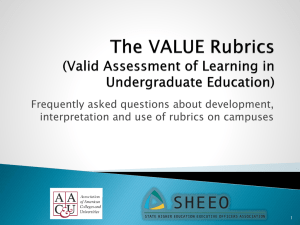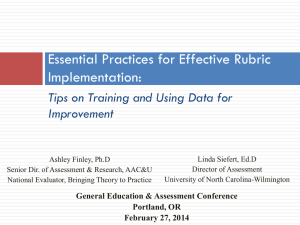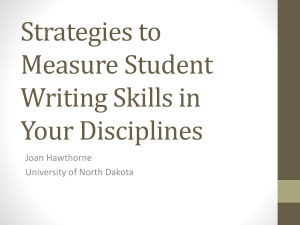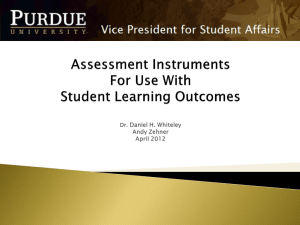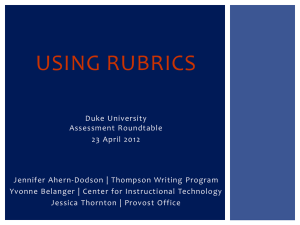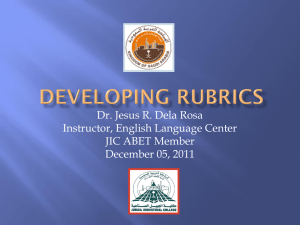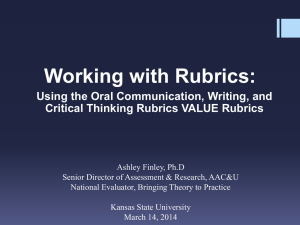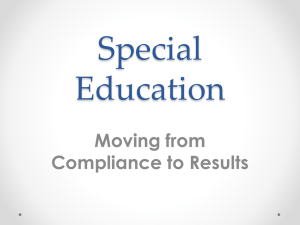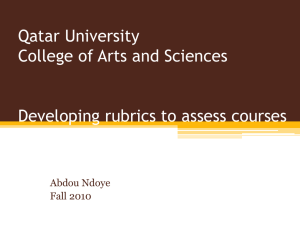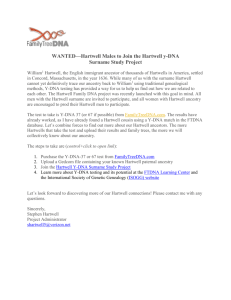Error analysis presentation
advertisement
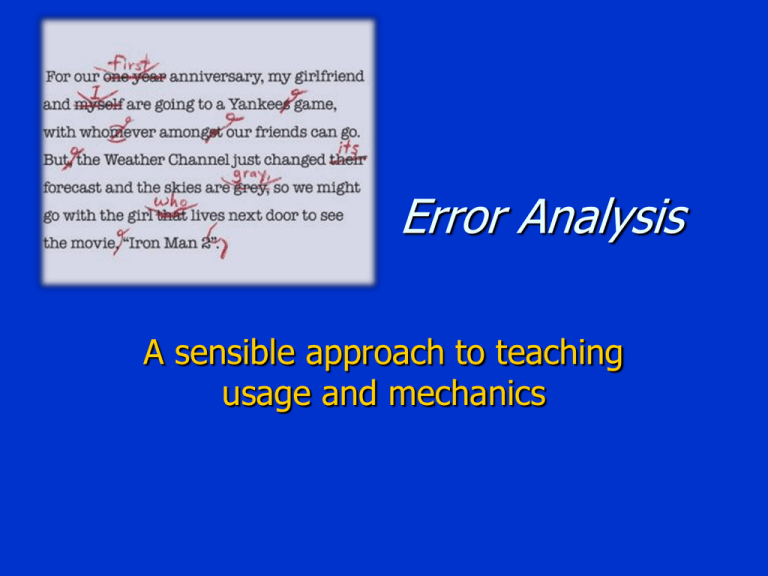
Error Analysis A sensible approach to teaching usage and mechanics Error Analysis “We have begun to view errors as exceptionally interesting clues about what is going on in our students’ minds, as clues to the linguistic and cognitive processes that function unobserved.” Kroll and Shafer, “Error-Analysis and the Teaching of Composition” Learning to Walk . . . http://www.youtube.com/watch?feature= player_embedded&v=fnFNy1RL97M Errors and Expectations by Mina Shaughnessy [S]tudents write the way they do, not because they are slow or non-verbal, indifferent to or incapable of academic excellence, but because they are beginners and must, like all beginners, learn by making mistakes. These they make aplenty for such a variety of reasons that the inexperienced teacher is almost certain to see nothing but a chaos of error when encounter[ing] their papers. Yet a closer look will reveal very little that is random or “illogical” in what they have written. And the keys to their development as writers often lie hidden in the very features of their writing that English teachers have been trained to brush aside with a marginal code letter or a scribbled injunction to “Proofread!” Such strategies ram at the doors of their incompetence while the keys that would open them lie in view. Learning to walk, you’re bound to fall. Learning to write, you’re bound to make errors. Errors can be a sign of development as a writer. You want to write a good paper. You should write several drafts. You should revise each as you go. To write a good paper, several drafts should be written. Revising as you go. To write a good paper, you should compose several drafts, revising as you go. How would you work with a student on this text? As a student, my grammar education was either nonexistent or taught via of worksheets. By eighth grade, my English teacher gave up on teaching how to diagram sentences so I never learned. Interpretations of Error How many errors? Errors are “bad.” Error represents failure to learn. What kind of errors? Why are the errors being made? Errors create an opportunity to understand strategies which led to the error. Errors indicate “teachable” material. Error is a natural part of learning, signaling active learning strategies. Where do errors come from? Overgeneralization: I walk, I walked I talk, I talked I see, I seed Ignorance of rule restriction: the dog’s bowl, the cat’s tail, it’s collar believe, relieve, recieve Where do errors come from? Misinterpretation of rule: I had planned to go on vacation; however, an emergency at work forced me to stay in town. . . . I was; however, glad to have that computer problem solved. Reliance on orality: I might could of done better in high school if I’d studied. Ferris squeal, sender blocks, soul poppers What do these excerpts have in common? In a nightclub in Louisville, a couple of guys, Rick and Lon, the duo who were providing the entertainment that night for the club. Rick plays an organ with three synthesizers included. The salesman tried to convince us that frozen vegetables are healthier than freshly picked ones. Nonsense. The researcher conducted a study on aggression. Introducing competing varieties of crabs into the same tank. “Mending the Fragmented Free Modifier” Muriel Harris “The fragment label is . . . [a] blanket term for several kinds of sentence errors that ought not to be equated.” If we don’t distinguish among different kinds of fragments, we may inhibit students from developing stylistically. Kinds of fragments Broken thought In sentence—fragmented, discontinuous a nightclub in Louisville, a couple of guys, Rick and Lon, the duo who were providing the entertainment that night for the club. Rick plays an organ with three synthesizers included. Kinds of fragments Minor sentence—express a complete thought, often caused by a misplaced period, separating it from the main or base clause with either precedes or follows it. The salesman tried to convince us that frozen vegetables are healthier than freshly picked ones. Nonsense. The salesman tried to convince us that frozen vegetables are healthier than freshly picked ones. That notion is nonsense. *He conducted a study on aggression. Introducing competing varieties of crabs into the same tank. He conducted a study on aggression, introducing competing varieties of crabs into the same tank. *I am attending college because I think it is a great experience. College is a chance of a lifetime. To get more out of life. I am attending college because I think it is a great experience. College is a chance of a lifetime, a way to get more out of life. *The two articles were challenging to read. Hartwell’s more than Martinsen’s level of diction. The two articles were challenging to read, Hartwell’s more than Martinsen’s because of his level of diction. Responding to error Hypothesis: college students tend not to use final free modifiers at all because Teachers stress the use of introductory phrases and clauses. Students fear final free modifiers may produce run-ons (if not punctuated) or sentence fragments (if punctuated too soon). Kinds of Free Modifiers Free Modifiers Free modifiers are all non-essential phrases and clauses set off by commas or other punctuation at the end of the sentence, after the bound predicate. Kinds of free modifiers: Nonessential prepositional phrase (see sentence above) Relative and subordinate clauses: Old Faithful is Yellowstone’s most famous geyser which sometimes reaches 150 feet in height. Nominative absolute—modifies the whole sentence; usually consists of a noun followed by a participle or participial phrase. Frank huddled over the fire, his hands shaking from the cold. Noun, verb, adjectival, and adverbial phrases Helen is my favorite aunt, a true friend who happens to be a relative. Example Try growing this sentence by adding modifiers to the end of the sentence: There is a tree in the yard of the house where I grew up. There is a tree in the yard of the house where I grew up, a sturdy maple, light green in the spring, dark green in the summer, ablaze in the fall, and stark against the gray winter sky. What can we say about this fragment? My purpose is to inform parents who have children enrolled in EBRP schools, about how their children are being divided by test scores and placed into classes and why this is so. Also, to question how and why this contradicts other efforts made by NCLB. My purpose is twofold: explaining to parents with children in EBRP schools how their children are placed into classes based on test scores and questioning whether such placements contradict other efforts made by NCLB. What can we say about this fragment? This paper could possibly be sent into the newspaper as a “letter to the editor.” My intended audience is those who read the newspaper. Especially focusing on parents and other non-educators who are interested in how the placing of students in classrooms is determined. This paper could be sent to a newspaper as a “letter to the editor.” My intended audience is general newspaper readers, especially parents and other non-educators who are interested in how students are placed in classrooms. Practicing Error Analysis Read for patterns of error; keep records of error to look for systems and patterns Investigate how the student arrived at the mistake Apply these insights to develop teaching strategies for correcting and avoiding the error by individual writers Use conferencing to discuss error Look for pattern of error. . . . I have mixed emotions about rubrics. I think that they can be helpful devices for informing a student of what is required of them or of the specific demands that a teacher would have them meet. I think giving a student a rubric with the assignment can help guide the student in their production process; however I think it may also inhibit creativity. . . . When rubrics have been given to me before an assignment is started it has helped me to identify components to include to be “successful.” Rubrics might also be helpful in a tutorial if the tutor gets the tutee to come up with the majority of it. Revised version I have mixed emotions about rubrics. I think that they can be helpful devices for informing a student of what is required of them or of the specific demands that a teacher would have them meet. I think giving a student a rubric with the assignment can help guide the student in their production process; however I think it may also inhibit creativity. . . . When rubrics have been given to me before an assignment is started it has helped me to identify components to include to be “successful.” Rubrics might also be helpful in a tutorial if the tutor gets the tutee to come up with the majority of it. (113) I have mixed emotions about rubrics. They can be helpful for informing a student of an assignment’s requirements or a teacher’s specific demands. Also, giving a student a rubric with the assignment can help guide the production of text. Rubrics, however, may also inhibit creativity. . . . When I get a rubric before I start an assignment, I use it to help me identify components to include to be “successful.” Rubrics might also be helpful in a tutorial if the tutor has the tutee compare the text with the criteria. (92) Reaction to error ++ A rule is violated; we respond. +- A rule is violated; we do not respond. -- My sister is older than me. A rule isn’t violated; we do not respond. It don’t matter. Most text we read falls into this category. -+ A rule isn’t violated; we do respond. It is I. I shall not attempt to defend his actions. Joseph Williams, “The Phenomenology of Error” What kind of errors is the writer making? Why? Marsha, ninety pound lighter, is a life-time Weight Watcher now. Watching television, she no longer eat potato chips. More and more often we find our ourselves stuck in traffic jams or involved in minor accidents. We just have to accept this as another remnant of Katrina. What kind of errors is the writer making? Why? Midterms are over, but I’m as busy as ever. Three projects are done, however three more are due in November. I did not do well in math, because I don’t understand my instructor. Hartwell’s minimal marking √ √p P sp ww Errors and Expectations by Mina Shaughnessy “[The writings] we have been looking at were written by students on the wrong side of the academic gap. We have sorted and analyzed various features of their writing in order not only to describe what goes wrong or what is missing but to understand the logic that underlies their behavior as writers.” Remember to praise Most student writing we read is correct. Most words are correctly used and spelled. Most sentences are correctly written and punctuated. Most texts are comprehensible. Every writer we work with can write. . . and she can learn to write even better.

